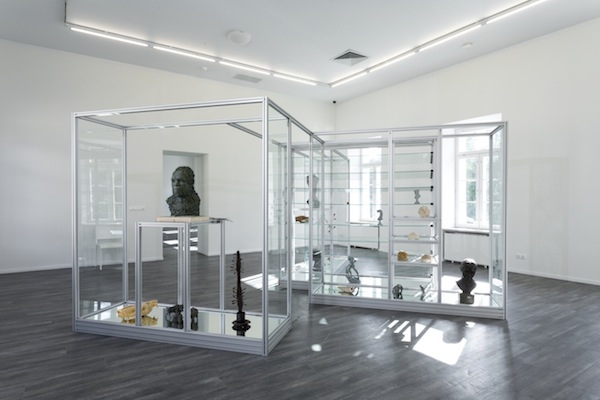Moscow Museum of Modern Art (MMOMA), 9 September – 5 November
The theorist Simon O’Sullivan likens the tool of the diagram to speculative fiction – that is, it’s not an illustration of how things are, but of how things might be. O’Sullivan’s notion comes to mind as one walks around this solo exhibition by Kirill Savchenkov, commissioned by the V-A-C Foundation over three rooms and two floors of MMOMA, in which the young Muscovite artist presents a series of enigmatic architectural and text installations that visualise otherwise invisible phenomena and abstract notions.
An almost mazelike series of chipboard partitions spreads throughout the ground floor. On one, neat vinyl lettering reads, ‘The Military Decision Making Process’. This is followed by a series of jagged bubbles containing field-command options with arrows leading from one to the next. ‘Algorithm 5: Priorities, Realities, Options, Ways’, reads one option (in Russian). Such flow charts, all couched in management speak, proliferate along the rough walls, leading would-be soldiers through their options on the combat field. Interrupting the texts are several metallic armatures, attached to which are items of military paraphernalia, including masks the SAS in Britain or Special Forces in the US might wear, Perspex sheets onto which are etched what might be maps or charts, and objects less obviously connected to the military theme: bits of foliage and alien figurines.
A floor work in the upper gallery, surrounded by vases of wilting flowers, attests to the often dire, and material, consequences of bad decisions. Again diagrammatical, white texts printed in Russian on grey matting catalogue the errors of the Chernobyl catastrophe. ‘Telegram messages not read’, reads one. ‘Flammable materials in the roof’ and ‘The lack of protective gear for radioactive fire’, read others. Decision-making is an abstract process, the work implies, but its effects are not: the former residents of the irradiated ghost town Pripyat can attest to that. Evolution, the subject of a second installation in the upper gallery, is similarly invisible, its effects recognisable only over thousands of years. Metal racks with glass shelves contain a vast array of what appear to be museum artefacts – plaster casts of monkeys, bones – each neatly labelled with an accession number. Among these, which together tell the scientific story of Darwin and Linnaeus, are stranger objects: the bust of a yeti, more aliens.
The final gallery, bathed in a pink light, is empty bar a loudspeaker, from which Simon & Garfunkel’s Homeward Bound (1966) plays on repeat. It is a strange, dislocating experience. On exiting the pink room and returning, blinking, to the gallery containing the artist’s alternative history of evolution, the light appears to have a green tinge. Everything is the same, but different.
From the Winter 2017 issue of ArtReview
